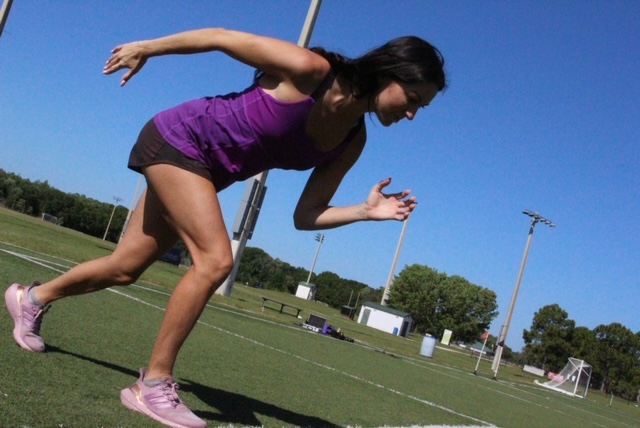
28 May Making Your Speed and Strength Workouts Effective
No one ever got better by going through the motions.
No one ever improved their performance by being comfortable.
No one ever improved skills by lacking focus.
No one ever succeeded by going half in.
For young athletes to get the most out of their training, they must have both intention and intensity.
For young athletes to get the most out of their training, they must have both intention and intensity. Share on X
Intention
This is the “why” behind the session. What is the goal? What is the specific adaptation that is to be achieved?
If it’s speed, you shouldn’t be jogging laps.
If it’s acceleration, you shouldn’t be doing drills longer than 4 seconds.
If it’s strength, you shouldn’t be lifting the same weight for a year.
If it’s power, you shouldn’t be lifting load slow.
It is critical to get clear on your intention for your workout, so you don’t waste your time, and you keep the goal the goal. Too often, I’ve seen Instagram posts with a caption something like this:
Doing speed work for off-season training. The grind never stops!
Meanwhile, the video doesn’t match the caption, and the athlete has a soccer ball at their feet, they’re tapping their toes through rings and ladders, and they’re going half speed. It looks terribly lazy, and is the furthest thing from a grind.
I still have to shout through the rooftops that if you’re training speed, you’re going max effort for 5-6 seconds, then resting a full five minutes or more between sprints. I always tell my female athletes in Tampa, Florida during our speed days, “run your 40 yard dash so hard you CRAVE that five minute rest.”
And they do. After a 40 yard, max effort sprint, their nervous system is dying for recovery. That’s speed training.
Note: in the video above, I am using the Freelap Timing System which gives my athletes accurate sprint times, so they can be competitive with themselves and others. Timing sprints brings out the intensity and provides data to track improvement. You must set up the first timing cone a few feet from your start position so the sensor can detect your motion.
So set your workout intention. Take action in your training that leads you to your exact goal. This includes being intentional with:
– Exercise prescription
– Work time
– Rest time
For off-season and in-season programs for specific speed and strength goals, check out The Strong Female Athlete Online Subscription HERE.

Intensity
As strength coach Tony Gentilcore says, “lifting weights isn’t supposed to tickle.”
Intensity is the effort behind the workout. It’s what amplifies your intention.
So if your intention is to gain speed, the intensity you bring comes from the max effort you give in your sprint and plyometric drills. Track coach Tony Holler says that speed should be electric, and it’s the most intense thing the body can do. You know you’re giving your best effort when you need that long 5 minute rest (or more) between sprints. Your motor units were recruiting so fast, they need a break.
If you intention is to gain strength, the intensity comes from progressing load, and not breezing through reps.
Of course, in the general preparation phase (first 4-6 weeks), you’re lifting light to moderate to build load your skill in performing a certain lift.
But as you progress, you shouldn’t be lifting the same weight.
When high school athletes lift 15 pounds on a Split Squat for several months, that is concerning. There needs to be a gradual progression in place, and you know when you’re challenging your load when you hit the 3-5 rep range, and the last few reps are a grind.
When a female athlete has been using the pull-up assistance band for several months, that is concerning. Eventually, this is going to be a breeze for her, so she needs to up the ante by ditching the band and just using her body weight to pull herself over the bar:
Strength workouts also have intensity when you focus on the muscles being used. One rule I have for my in person athletes is you cannot talk during a set. If an athlete is doing a deadlift, for example, they must focus on their form, their hamstrings and glutes, their breathing, and posture.
When their focus is sharp during the set, they’re much more able to execute quality form, push themselves, or go up in load. The nervous system cannot multi-task while performing a highly technical skill. It bodes well to not talk about friend drama, prom, or the most recent episode of Stranger Things while deadlifting. ;-O Save the socializing for the rest in between sets.
It’s important to note that intensity doesn’t mean:
– Break a sweat
– Puke at the end of a session
– Be so sore you can’t walk upstairs
I train my athletes 4x a week in the off-season. If everyone was sore after EVERY workout, we wouldn’t get much done. They would have no gas left in the tank to be explosive in our jump drills, or rapid in their accelerations, or energized for a 3 rep max session. We wouldn’t be getting the physiological adaptations we are seeking, namely speed and strength.
True intensity is looking at your performance measurements for the day, week and month – your strength numbers, your broad and vertical numbers, your sprint times. There must be improvement over time. Just because you’re drenched in sweat and puked on the sideline, doesn’t mean you got better.
Just because you're drenched in sweat and puked on the sideline, doesn't mean you got better. Share on XYou get the most out of your workouts by having intention and intensity, and both of these involve being meticulous with exercise choice, sets and reps, work and rest time, as well as coming with a focused and disciplined attitude.
For a guide book on training the youth female athlete, get The Strong Female Athlete HERE

For detailed conditioning programming based on training age, maturity, and in-season of off-season, sign up for one of The Strong Female Athlete online training subscriptions to transform your speed, strength and conditioning HERE



No Comments